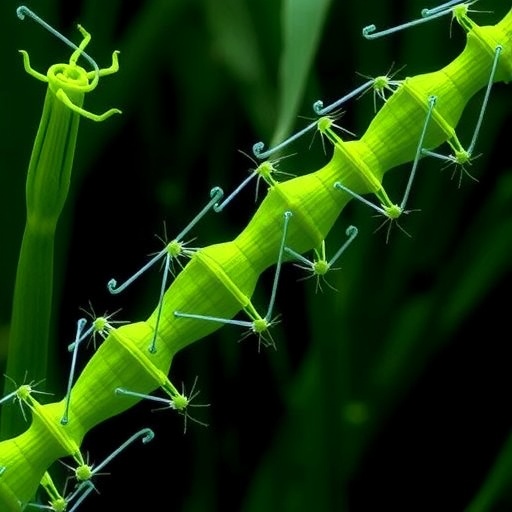The intricate process of plastid DNA replication is vital to the proper function and development of plant cells, yet many details about its underlying mechanisms have remained elusive. In a groundbreaking study published recently in Nature Plants, researchers have uncovered a key player responsible for the removal of RNA primers during plastid DNA replication in maize. This discovery not only solves a long-standing mystery in plant molecular biology but also promises to pave the way for new advances in plant genetics and biotechnology.
Plastids, the organelles responsible for photosynthesis and various anabolic activities in plant cells, possess their own genomes, and the faithful replication of this plastid DNA (ptDNA) is crucial for cellular energy metabolism and plant development. Replication in these organelles begins with the synthesis of RNA primers by primases, which provide the starting points for DNA polymerases to elongate new strands. However, this RNA must be removed and replaced with DNA before the nascent strands can be ligated to produce continuous DNA. The enzymatic machinery and precise mechanisms responsible for the excision of these RNA primers in plastids had, until now, been poorly characterized.
The team, led by Huang, Shi, and Xiao, identified and cloned a gene from maize encoding a plastid-localized enzyme they designated PEN1. Intriguingly, PEN1 is a 5′ to 3′ exonuclease that depends on manganese ions (Mn^2+) for its catalytic activity. This enzyme demonstrated a unique ability to cleave RNA primers from the DNA-RNA hybrid regions generated at replication forks in plastids. The removal of these RNA fragments is essential for maintaining the integrity of the plastid genome and facilitating proper DNA replication.
.adsslot_RO4GSPuqdn{ width:728px !important; height:90px !important; }
@media (max-width:1199px) { .adsslot_RO4GSPuqdn{ width:468px !important; height:60px !important; } }
@media (max-width:767px) { .adsslot_RO4GSPuqdn{ width:320px !important; height:50px !important; } }
ADVERTISEMENT
Detailed biochemical assays showed that PEN1 could excise ribonucleotides completely, ensuring that subsequent DNA synthesis could proceed unhindered. Importantly, the study demonstrated the in vitro reconstitution of the RNA primer removal process, using purified components to recapitulate plastid DNA replication dynamics. This methodological breakthrough allowed the researchers to observe PEN1’s activity in real time and to verify its pivotal role in this critical step.
Structurally, the researchers solved the crystal structure of the PEN1 enzyme in complex with double-stranded DNA. This high-resolution structure revealed the molecular basis for PEN1’s 5′ to 3′ exonuclease activity. The enzyme’s active site forms crucial interactions with the DNA substrate and coordinates Mn^2+ ions, which facilitate the hydrolytic cleavage of the RNA primers. Conformational changes upon substrate binding elucidate how PEN1 distinguishes RNA-containing regions from DNA, ensuring specificity in primer removal.
Beyond its immediate implications in maize biology, the discovery of PEN1’s enzymatic mechanism illuminates broader questions about DNA replication in organelles. Comparable to the well-characterized systems in mitochondria and bacteria, plastid replication now gains a clearer molecular framework, positioning PEN1 alongside other nucleases that maintain genome integrity. This finding could serve as a foundation for exploring similar mechanisms in other plant species and plastid types, including chloroplasts and chromoplasts.
The study also raises intriguing possibilities for crop improvement. By understanding the role of PEN1 in plastid DNA replication fidelity, biotechnologists might one day engineer plants with enhanced genome stability under stress conditions, potentially improving yield and resilience. The insights into the RNA primer removal process could lead to novel strategies for manipulating plastid genomes as well, with applications in synthetic biology and metabolic engineering.
Notably, the team’s approach combined genetics, biochemistry, structural biology, and plant physiology, offering a comprehensive portrait of PEN1’s function. This integrative strategy exemplifies the power of multidisciplinary research to tackle longstanding mysteries in cellular biology. The structural elucidation, in particular, provides a detailed template for designing inhibitors or modulators that could further probe PEN1’s function or potentially control plastid genome replication.
In sum, the identification of PEN1 as the crucial enzyme for RNA primer excision in maize plastids represents a pivotal advance in plant molecular biology. It brings to light the enzymatic sophistication underlying organellar genome replication and maintenance. As researchers continue to unravel the layers of plastid biology, discoveries such as this provide the biochemical foundations vital for innovation in plant science.
The impact of this research extends beyond basic science, offering a molecular target for potential genetic interventions aimed at enhancing crop productivity and sustainability. By ensuring that plastid genomes replicate error-free, plants maintain the photosynthetic and metabolic machinery necessary for growth and adaptation. PEN1 stands at the heart of this process, a guardian of plastid genome integrity whose discovery will resonate throughout the fields of genetics and agriculture for years to come.
Subject of Research: Plastid DNA replication and RNA primer removal mechanisms in maize.
Article Title: PEN1 catalyses RNA primer removal during plastid DNA replication in maize.
Article References:
Huang, X., Shi, G., Xiao, Q. et al. PEN1 catalyses RNA primer removal during plastid DNA replication in maize. Nat. Plants (2025). https://doi.org/10.1038/s41477-025-02027-4
Image Credits: AI Generated
Tags: biotechnology applications in plant scienceDNA polymerases in plastid replicationenzymatic machinery in plastidsmaize genome studiesmaize molecular biology researchPEN1 gene in maizephotosynthesis and plastid functionplant genetics advancementsplastid DNA replication mechanismsRNA primer removal in plastidsRNA to DNA conversion in plantsrole of plastids in plant development





